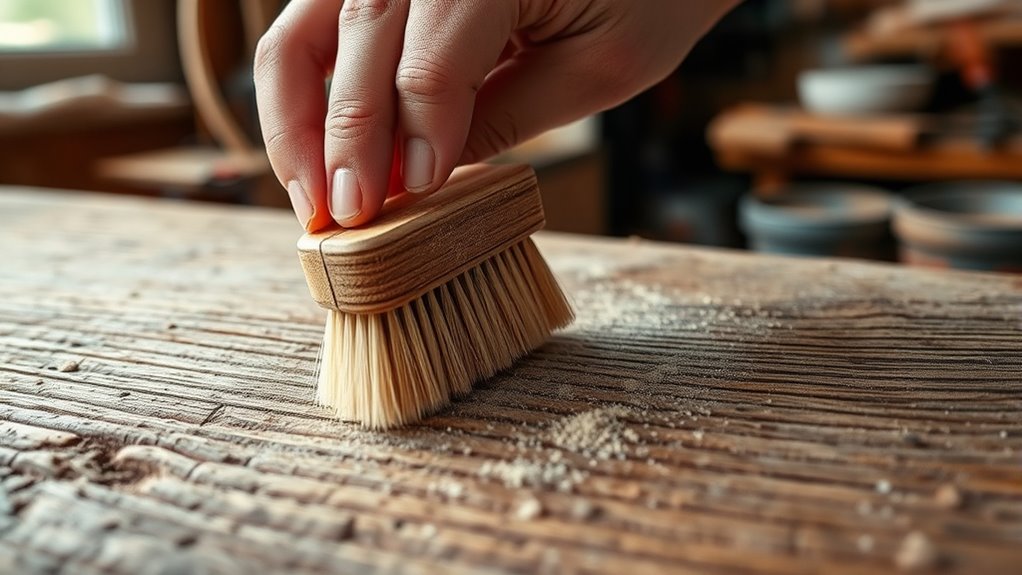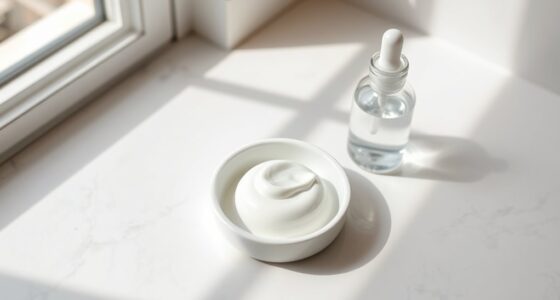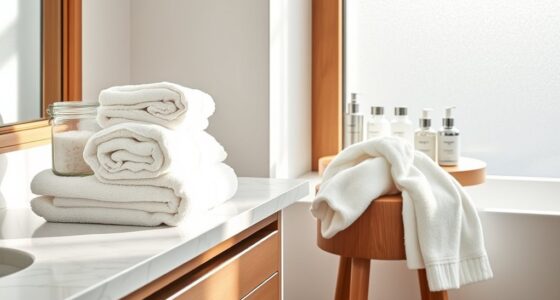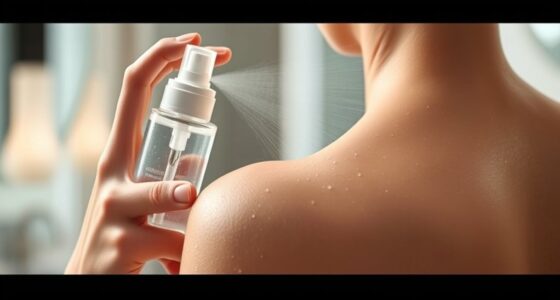Dry brushing can boost your skin’s appearance by exfoliating dead cells, increasing blood flow, and supporting lymphatic drainage. It might improve your skin’s texture temporarily and give you a natural glow. However, it won’t eliminate cellulite, stretch marks, or treat skin conditions like eczema or acne. Overdoing it can cause irritation, so proper technique and routine are key. If you want to uncover more about what dry brushing can and can’t do, keep exploring this topic.
Key Takeaways
- Dry brushing stimulates lymphatic flow, exfoliates skin, and temporarily improves skin texture and glow.
- It cannot permanently eliminate cellulite, stretch marks, or treat skin conditions like eczema or psoriasis.
- Proper technique and gentle strokes are essential to prevent skin irritation or damage.
- It does not detoxify the body; liver and kidneys handle detoxification processes.
- Regular use with moisturization supports skin health but isn’t a cure for underlying skin issues.
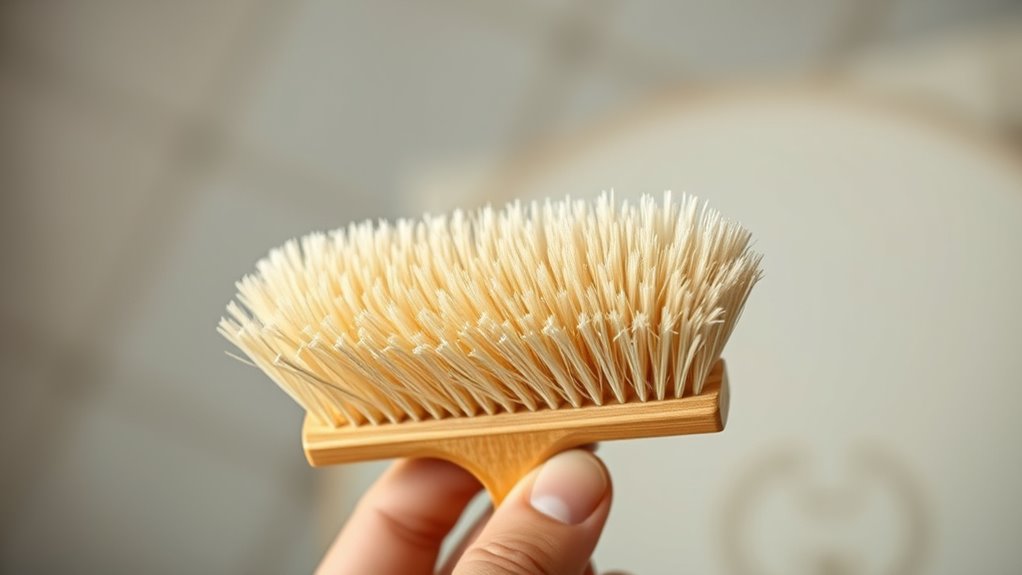
Have you ever wondered if dry brushing can truly benefit your skin? Many people swear by it, claiming it improves circulation, sloughs off dead skin, and even boosts your mood. But before you start scrubbing away, it’s important to understand what dry brushing can actually do—and what it can’t. Dry brushing involves using a stiff-bristled brush, typically made of natural fibers, to brush your skin in long, sweeping strokes. You usually do this before showering or bathing, on dry skin. The main idea is that the brush stimulates your lymphatic system, encourages exfoliation, and promotes healthier-looking skin.
Dry brushing stimulates lymph flow, exfoliates skin, and can boost your mood naturally.
In reality, dry brushing does help remove surface dead skin cells. When you brush your skin, you slough away the dry, flaky outer layer, leaving your skin feeling smoother and softer. This can give your skin a more radiant appearance, especially if you regularly incorporate it into your routine. Plus, the act of brushing stimulates blood flow, which some believe can help with a temporary glow and improve overall skin tone. It’s also thought to support lymphatic drainage, potentially reducing the appearance of cellulite and swelling, although scientific evidence for these claims remains limited. Proper technique is crucial to avoid skin irritation and maximize benefits.
However, it’s *essential* to be realistic about what dry brushing can’t do. It won’t permanently reduce cellulite or eliminate stubborn skin conditions like stretch marks. While it might temporarily improve skin texture, it’s not a miracle cure. If you have skin issues such as eczema, psoriasis, or active acne, dry brushing can actually irritate or worsen your condition. The skin can become inflamed or damaged if you brush too aggressively or if your skin is already compromised. It’s also not suitable for broken or irritated skin, and overdoing it can lead to microtears or irritation.
Another misconception is that dry brushing will detoxify your body. While stimulating your lymphatic system can support your immune health, dry brushing alone doesn’t detoxify your entire system. Your liver and kidneys do that, not your skin. It’s also worth noting that dry brushing can cause skin dryness or irritation if you don’t moisturize afterward or if you brush too vigorously. To get the most benefit without risking harm, use gentle, firm strokes and keep the brush clean. Follow up with a good moisturizer to soothe your skin and maintain hydration.
Frequently Asked Questions
Can Dry Brushing Replace Exfoliating Scrubs?
Dry brushing can’t fully replace exfoliating scrubs, but it complements them. While dry brushing stimulates circulation and helps remove dead skin through a gentle, manual method, exfoliating scrubs often contain ingredients that target deeper layers or specific skin concerns. You should incorporate both into your routine for *the best* results. Use dry brushing regularly for overall skin health, and reserve exfoliating scrubs for deeper, occasional exfoliation.
How Often Should I Dry Brush for Best Results?
You should dry brush 2 to 3 times a week for the best results. This frequency allows you to effectively exfoliate your skin without causing irritation. Make sure to use gentle, upward strokes and avoid overdoing it, as too much brushing can lead to dryness or redness. Pay attention to how your skin responds, and adjust the frequency if needed to keep your skin smooth and healthy.
Is Dry Brushing Safe for Sensitive Skin?
Yes, dry brushing can be safe for sensitive skin if you proceed with caution. Use a soft-bristled brush and gentle pressure to prevent irritation. Start with brief sessions, around 1-2 minutes, and watch for any redness or discomfort. If your skin reacts negatively, stop immediately and consult a dermatologist. Always moisturize afterward to soothe your skin and maintain its health.
Does Dry Brushing Help With Cellulite Reduction?
Think of dry brushing as polishing a gemstone—you might enhance its shine, but it won’t change its core. Similarly, dry brushing can temporarily improve skin texture and boost circulation, making cellulite less noticeable. However, it doesn’t break down fat or eliminate cellulite’s underlying causes. I’ve seen friends swear by it, but remember, consistent skincare and healthy habits are key for real results.
Are There Any Health Risks Associated With Dry Brushing?
Yes, there are health risks associated with dry brushing if you’re not careful. You might irritate or damage your skin, especially if you brush too hard or use a harsh brush. It can also cause small cuts or abrasions that increase the risk of infection. To stay safe, always use gentle pressure, avoid broken or irritated skin, and clean your brush regularly. If you experience pain or redness, stop immediately.
Conclusion
While dry brushing might offer some gentle benefits, remember it’s not a miracle cure for all skin concerns. Think of it as a small, supportive step in your skincare routine rather than a game-changer. Listening to your body and maintaining a balanced approach will serve you best. Embrace the process with patience and care, knowing that true wellness comes from consistent habits, not quick fixes. Your skin will thank you for your gentle, thoughtful attention.
